A Stage for Human Narratives: Goodbye to Love by Hyesoo Park
Eunju Lee (Independent curator/ Art historian)
Hyesoo Park is known for the works that are usually preceded by collecting an extensive amount of data. The large-scale exhibitions at major public museums she had participated in have functioned as a platform that enabled her to gather survey answers and to have many anonymous audiences involved with her work, which led to a following piece. Artists inevitably have to reserve control over their work because the completion of such work cannot depend entirely upon a studio practice. Thus, many artists hesitate to adopt this process that invites the audience to the artist‘s stage, based on a social relationship with the public. As I have observed Park's several projects for a long time, I was always curious about what motivates her to endure such a complicated process.
When I saw one of Park’s works, To Future Generations (2019), at the Korea Artist Prize exhibit at MMCA Seoul 2019, I realized what makes her continue the projects and why they are significant. With the theme of the lonely deaths of elderlies, this work depicts institutional limitations and the illusional ideology of family entwined with our lives where death is unavoidable, in a documentarian expression without any exaggerated eloquence. I once read a notice in the newspaper about the dead body of an unidentified person to be disposed of, and it made me wonder about the death of the person that would never be represented by a nonchalant notice. I kept the newspaper for a long time as a bookmark, pondering how we should mourn for one’s life and death which cannot be wholly conveyed in a news article. Park’s To Future Generations evoked the very memory, and I realized her works are significant in the way that they visualize and deliver the issues in life existing beyond social statistics and information in different manners from the newspaper. A documentary of realities in this work was given dynamic perspectives and sentiments of human narratives in the exhibition set up as a stage, distinguished from indifferent information in journalism.
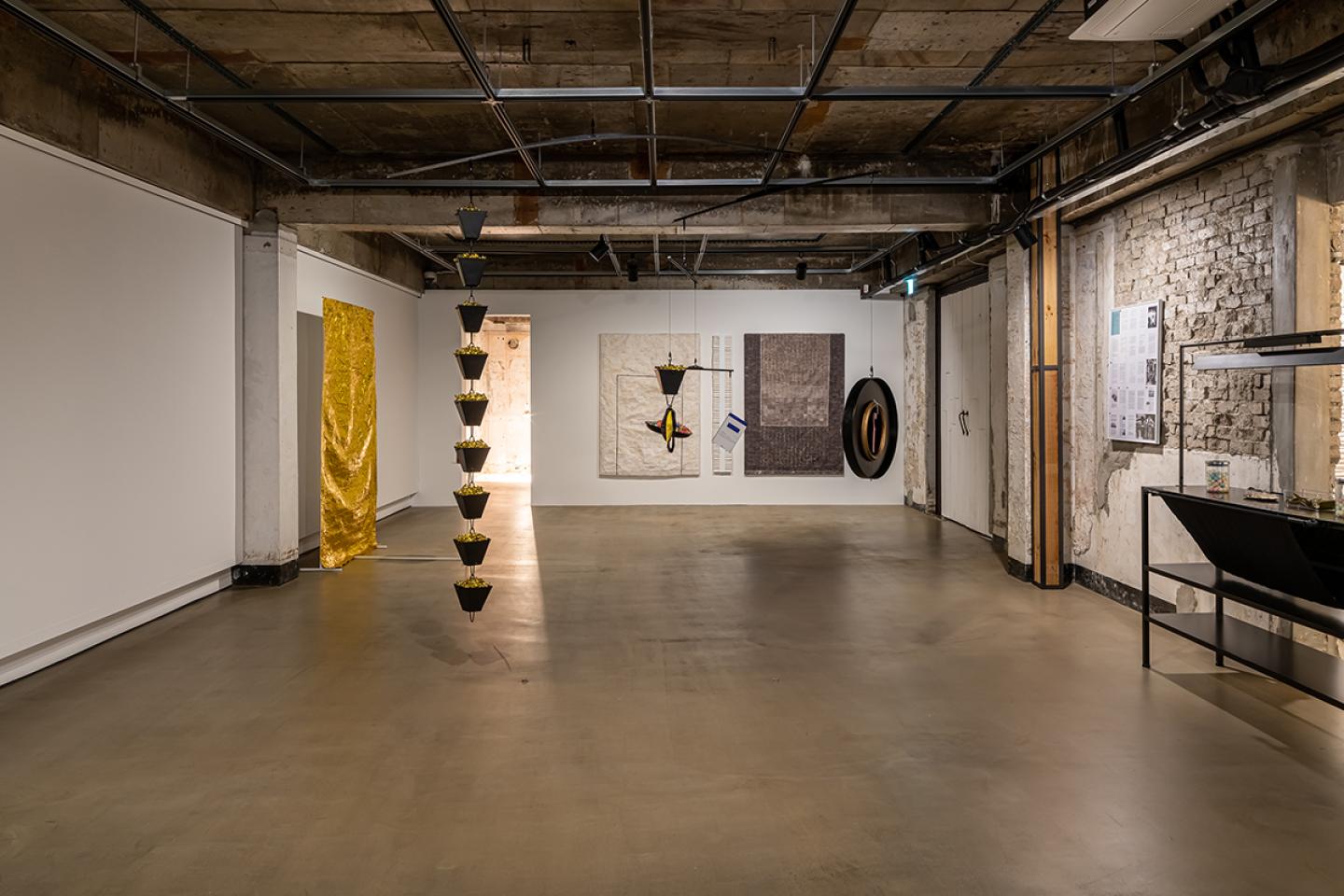
As an artist who has established a unique artistic position with works between research and art, Park demonstrated this style more clearly at her solo exhibition Monophobia held at the Art Centre Art Moment in September 2022. This exhibition was the final edition of Goodbye to Love, the second volume of the project Dialogue that began in 2013. She had collected breakup stories and leftover objects, and the stories extracted from the vast amount of archived materials became the content of the exhibition. She took a reference from the plot of the movie Memories of Matsuko (嫌われ松子の一生) for the composition of the exhibition. Matsuko’s life is just a dramatic fiction where she eventually becomes a social recluse (also known as hikikomori) as she withdraws herself from society after she gets hurt by relationships. Matsuko’s story, however, obtains the sense of reality as an event that may happen to anybody when it overlaps with the quality of documentarian truth extracted from real breakup stories in Park’s work.
Park created a narrative for each floor of the Art Centre Art Moment, based on the fact that the building used to be a former dormitory for factory girls at the Guro Industrial Complex. On the second floor, she emphasized the gap between the fantasy of the young factory girls dreaming of a bright future and the hopeless reality through the installation work in the form of an assembly line at a doll factory. And she made the audience witness the evidence of failed relationships by displaying the breakup leftovers she collected from anonymous people. Combined into one storytelling with the fictional setting of her work, the evidence of breakups from real life, neither revisable nor deniable, creates a distinctive zone between documentary and fiction. In this way, the fictional hypothesis Park invented about the factory girls of the Guro Industrial Complex becomes a metaphor for the universal realities that anyone might undergo.
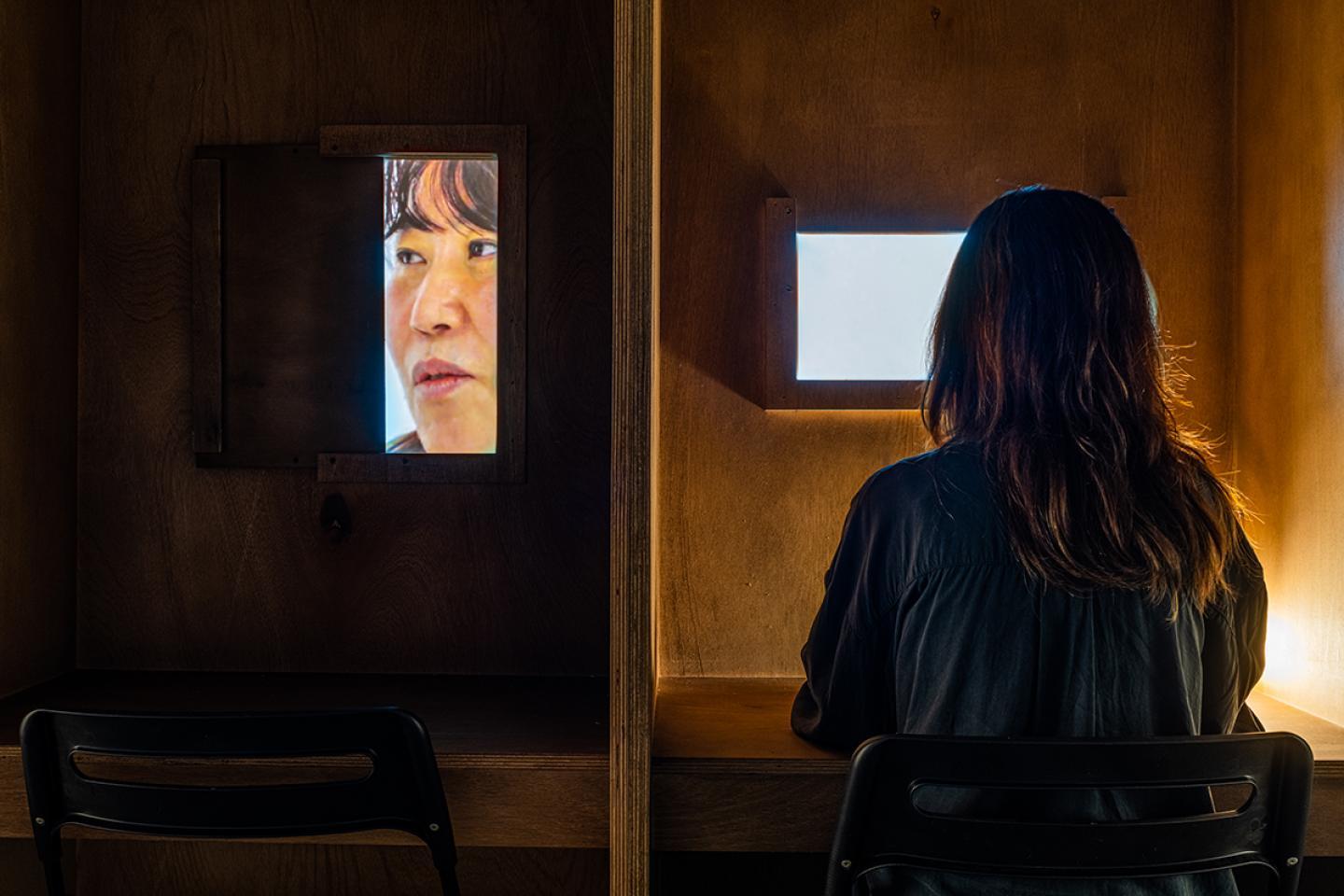
And the fourth floor of the Art Centre Art Moment was created as a space for hikikomori who completely shut down from the world like Matsuko at the end of Memories of Matsuko. The gallery composed of structures resembling a library study room, restaurant with solo-dining booths, or small room, symbolized that a public place embraces the psychological space of hikikomori. Once the artist said her ultimate goal with the project is to make them “open up by any means,” and this installation piece itself embodies such an idea by placing a space of isolated individuals in a public area. She placed a screening of a video, Our Joyful Young Days (2022), over the partitioned structure, which was previously shown at the exhibit My Your Memory at MMCA Seoul in 2022. In that way, the audience could watch and listen to the stories of people in the video as if they peeped through a small window of the room. People's somewhat blushing faces in the video when they recollect the memories of their first love seemed to emit calm yet hopeful light through the cracks between the divided space. It can be perceived as a secret connection with the world that reclusive people keep deep in their minds or the last key that opens the door again.
Park filled each different section from the second to the fourth floor with the chronological narrative recalling a life of an unspecified somebody, richly weaving a story between fiction and the real. Existing between documentary and fiction, the narrative she built reduces the unbearable weight of documentary and, at the same time, incapacitates the eyes that objectify others through the fictional element. In this way, Park's unique storytelling is established, which is dramatic as fiction yet contains the reality of the documentary. The audience may be emotionally absorbed into the protagonists in the narrative without objectifying them as when they read about someone on the paper, while, at the same time, keeping their distance from the complete absorption. It is as if we get involved with a role-play of another life that is not completely irrelevant to mine.
Perhaps this effect is possible because Park’s works contain stories excerpted from a large number of actual episodes. The survey data may not be more than insignificant and sporadic information, but the narrative derived from them may be considered as a play that creates a world where protagonists unfold the story, and it obtains universal extendability through the audience’s emotional involvement. The survey data as human narratives acquire vividness, otherwise, just data, that encompass our own lives as well, and the audience becomes the protagonist by sympathizing with the stories and, at the same time, taking part in the life of others as a role-play. Park’s work is significant in that she attracts random individuals into a stage of life that is universally relatable in such a manner. Her works are often composed with a set of the stage open to anybody, as in Forum Theater: URI, where the anonymous group of people becomes both audience and the main character that runs the universal human narratives.
The data from real life that Park has constructed with lots of surveys and research are the foundation for grasping the universal state of humans that live in precarious conditions. However, it is crucial to notice that the ‘universal’ that Park captures here is distinguished from the socially normative ‘universal.’ Her ‘universal’ is a common foundation that human nature shares rather than a standardized measurement. This particular nature attracts more people to her works and continuously invites them into the story of a following piece – the audience can listen to its own and all of our stories, not strangers. The human narratives her work represents are based on universality without interfering with personal value and also serve the part of diagnosis and consolation to many problems caused by the social collectivity. This is how her work at the exhibit Monophobia can be related to the stage reading, participatory theater, and collaboration with hikikomori-related activists. Hyesoo Park builds a stage for the play about human narratives and invites people into it. Through this artistic process, she designs a way of socially involving and embracing people’s wounds in a different area from the social activists.
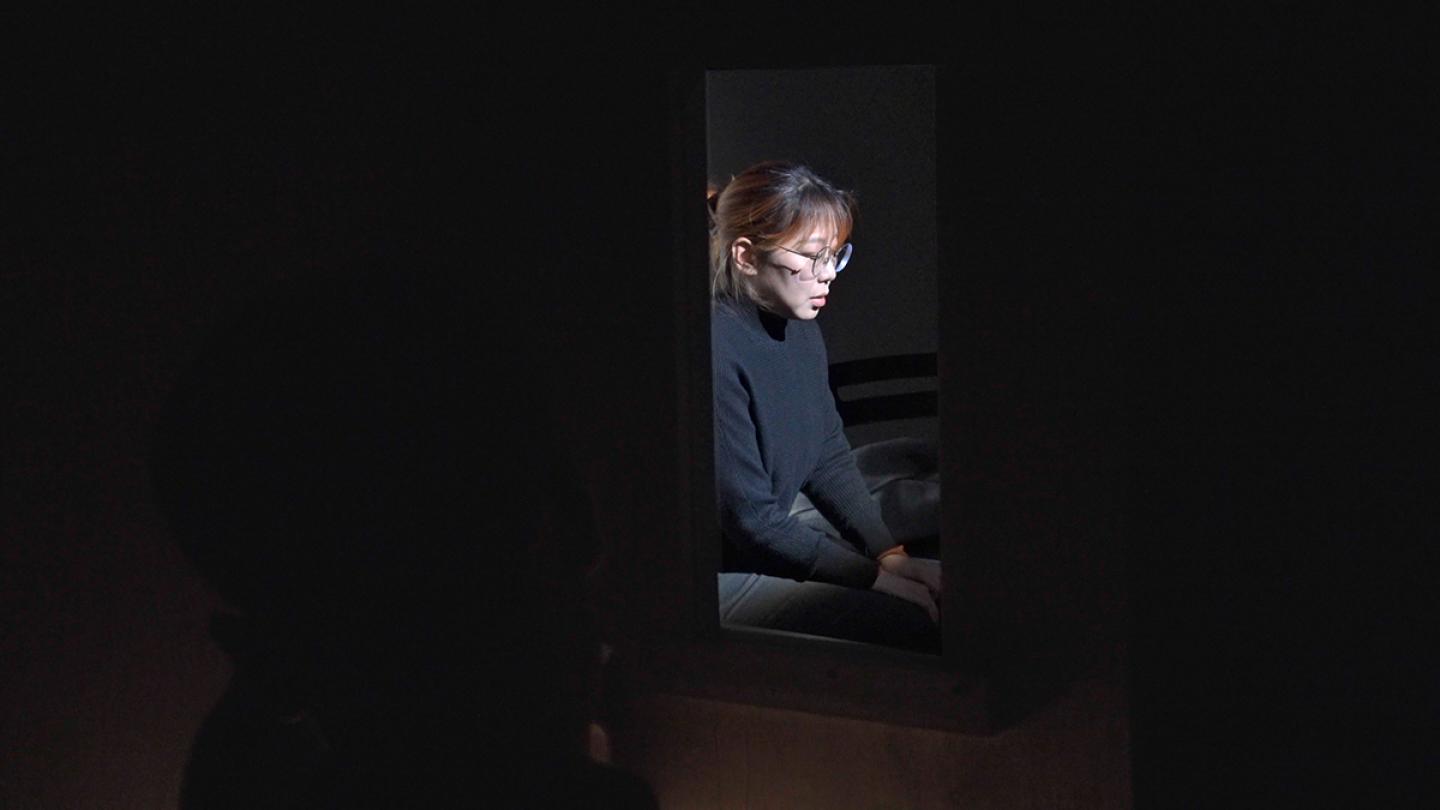
인간 서사의 무대 : 박혜수의 ‘굿바이 투 러브’
이은주 (독립기획자, 미술사가)
박혜수의 작업은 대부분 방대한 분량의 자료 아카이빙이 선행된다는 점이 특징적이다. 그가 참여했던 국공립미술관의 대규모 기획전들은 설문조사를 용이하게 하고 수많은 익명의 대중들을 그의 작업 안으로 새롭게 끌어들여 다음 작업으로 이어지게 하는 플랫폼이 되어왔다. 대중과의 사회적 관계를 전제로 하면서 그들을 작가가 만드는 무대 위로 호출하는 이러한 절차는 실상 많은 작가들이 피하고 싶어하는 과정이다. 작업실 안에서 홀로 완결될 수 없는 제작 조건을 전제로 하기에, 작품에 대한 작가의 통제력을 스스로 유보할 수밖에 없기 때문이다. 박혜수의 다양한 프로젝트를 오랜 기간 지켜보면서, 이 모든 수고스러운 절차를 기꺼이 감내하게 만드는 원동력이 무엇일지 궁금했었다.
박혜수의 프로젝트를 지속시키는 동기와 그 의미를 필자에게 처음 깨닫게 했던 작업은 2019년 국립현대미술관의 ⟪올해의 작가상⟫ 전시에서 본 ‘후손들에게’(2019)였다. 고독사로 사망한 노인들의 사연을 다룬 이 작업은 죽음을 향해갈 수밖에 없는 우리 모두의 삶에 얽혀있는 제도적 그물망과 가족이라는 이데올로기의 허상을 다큐멘터리의 어법을 빌어 과장된 웅변 없이 그려냈다. 필자는 언젠가 신문에서 무연고자의 시신 처리를 위한 고지문을 우연히 접하고, 그 건조한 고지문으로 결코 대변할 수 없을 무명한 한 인간의 죽음에 대해 생각해본 적이 있었다. 객관적 정보라는 것에 담기지 못하는 한 인간의 희로애락과 삶의 종결을 어떻게 애도해야 할 것인가라는 심정으로 오랫동안 그 신문조각을 버리지 못한 채 책갈피에 꽂아 간직했었다. 박혜수의 ‘후손들에게’는 필자에게 이 기억을 불러일으키면서, 사회적으로 통계화된 정보나 제도가 포섭하지 못하는 삶의 문제를 신문기사와는 다른 화법으로 주지시키고 시각화하는 작업의 의미를 깨닫게 했다. 여기에서 펼쳐지는 현실 속의 다큐멘터리는 일종의 무대처럼 설정된 전시장이라는 공간 안에서, 저널리즘 속의 냉랭한 정보와는 다른 인간 서사의 입체적인 각도와 정서를 부여받는다.
리서치와 예술작업 사이에서 자신만의 특수한 예술가적 위치를 찾아낸 박혜수의 태도는 2022년 9월 ‘예술의 시간’에서 열린 개인전 ⟪모노포비아 – 외로움 공포증⟫에서 한층 더 분명하게 드러났다. 이 전시는 2013년부터 시작된 <다이얼로그 Dialogue> 프로젝트 Vol.2 <굿바이 투 러브 Good Bye to Love>의 완결판이었다. 박혜수는 이 작업을 위해 십 년에 가까운 기간 동안 실연 사연과 물건을 수집해왔고, 엄청난 분량의 아카이빙을 통해 추출한 서사가 곧 전시의 내용이 되었다. 박혜수는 이 전시의 구성을 위해 영화 <혐오스런 마츠코의 일생>의 스토리 전개를 참고했다고 한다. 사랑을 원하던 관계로부터 상처를 받고 점진적으로 외부 세계에 마음을 닫으면서 히키코모리가 되어간 마츠코의 일생은 하나의 극적인 허구일 뿐이다. 하지만 박혜수의 작업에서 그 이야기는 실제 실연 사연들로부터 추출한 다큐멘터리적 진실성과 연동되면서, 누구에게나 벌어질 수 있는 개연성 있는 서사로서의 리얼리티를 획득했다.
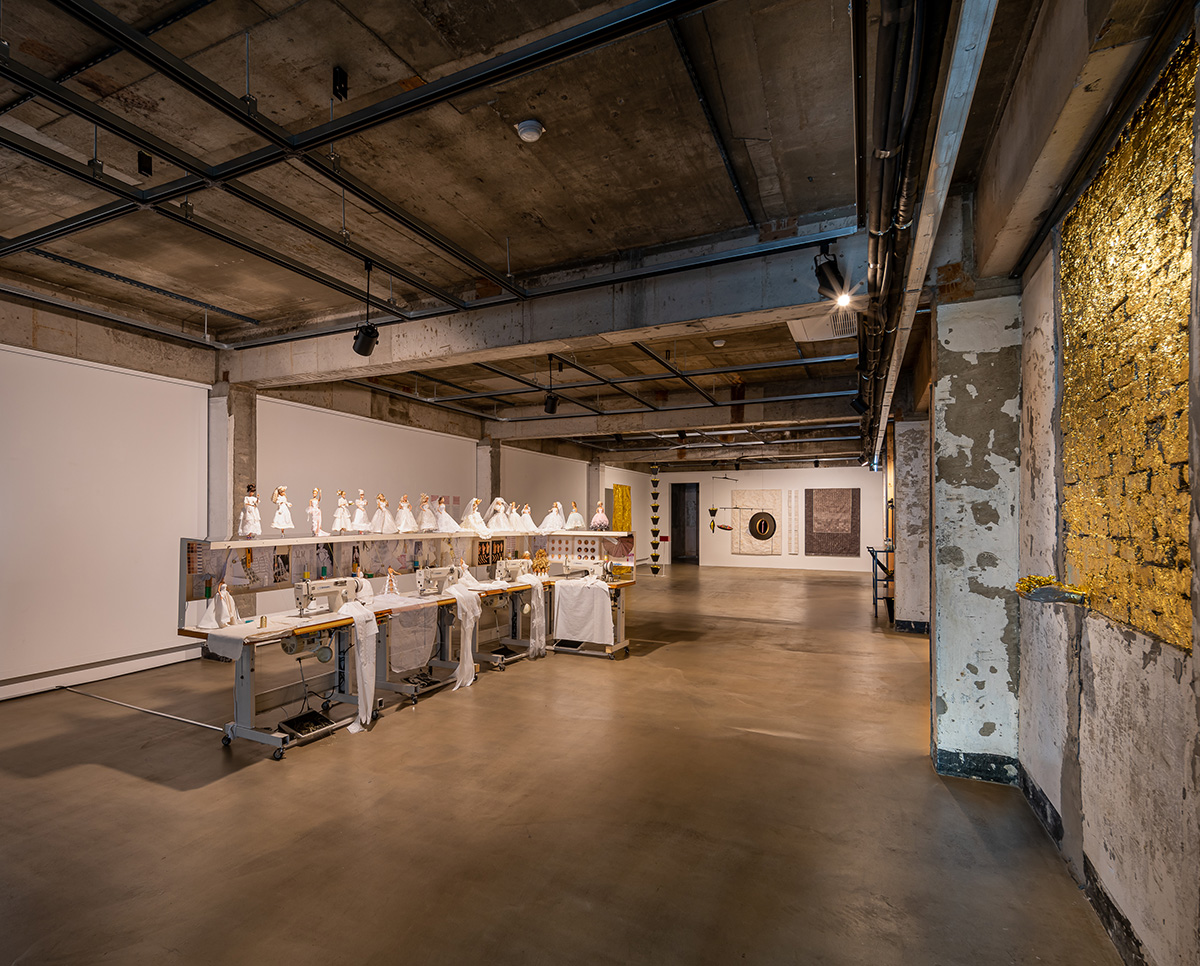
모토포비아 (전시전경)_ 아트센터 예술의 시간 제공
박혜수는 ‘예술의 시간’의 전시 공간이 한때 구로공단의 여공들의 기숙사였음을 주지하면서 각 층의 서사를 구성했다. 2층에서는 바비인형을 만드는 공장의 생산라인을 연출한 설치를 통해 장밋빛 미래를 꿈꾸면서 공장에서 일하고 거주하던 어린 여성들의 판타지와 서글픈 현실 사이의 괴리를 동시에 느낄 수 있게 했다. 이어서 박혜수는 그가 실제로 수많은 익명의 대중들을 대상으로 조사하고 수집했던 실연 물품들의 설치를 통해, 현실에서 부딪힌 관계에 대한 좌절의 증거들을 관람자가 직접 목도하게 만들었다. 이처럼 실제 현실 속에 있는, 결코 미화하거나 부인할 수 없는 실연의 증거물들은 작가가 만든 허구적 설정과 하나의 스토리텔링으로 엮어지면서 다큐멘터리와 픽션 사이에 있는 독특한 지대를 형성하게 된다. 이로써 박혜수가 만들어낸 구로공단 여공들에 대한 허구적 가설이 누구나 경험할 수 있는 보편적 진실에 대한 은유가 될 수 있는 것이다.
이어서 ‘예술의 시간’ 전시장의 4층은 <혐오스런 마츠코의 일생>의 마지막 국면처럼 외부 세계에 대해 마음의 문을 완전히 닫아버린 히키 코모리의 공간으로 구성되었다. 독서실, 쪽방, 1인용 칸막이 식당을 연상시키는 구조물로 채워진 전시장은 히키코모리의 심리적 장소를 공공적 장 안에 포용한 것이라 할 수 있다. 이 설치작업은 단절된 개인의 공간을 전시장이라는 공적 영역 안에 위치시킴으로써 박혜수 스스로 이 작업의 궁극적 목표라고 밝혔던 “어떻게든 문을 열게 만드는” 기능을 그 자체로 내포하고 있다. 그는 이 쪽방과 같은 구조물 너머로 2022년 국립현대미술관 ⟪나너의 기억⟫에서 선보였던 영상 ‘기쁜 우리 젊은 날’(2022)을 상영하여, 구획된 쪽방 안의 작은 창문을 통해 엿보듯이 영상 속 인물들의 이야기를 듣고 볼 수 있게 했다. 첫사랑의 기억을 떠올리는 얼굴들의 어딘지 상기된 표정들은 단절된 개인의 방들 틈 사이로 덤덤하지만 여전히 희망적인 빛을 방사하는 듯하다. 그것은 외부 세계로부터 문을 닫은 자들의 마음 깊은 곳에 남겨진 세상과의 숨겨진 연결고리이자, 닫힌 문을 다시금 열 수 있게 하는 최후의 열쇠처럼 느껴지기도 한다.
이처럼 박혜수는 전시장의 2층에서 4층에 이르는 다양한 섹션의 공간들을 특정한 누구라 지명할 수 없는 어떤 인생을 떠올리게 하는 연대기적 서사로 구성하여, 허구와 진실 사이의 이야기를 풍성하게 직조했다. 다큐멘터리와 픽션 사이에 박혜수가 구축한 이 서사는 맞닥뜨리기 힘든 현실적 다큐멘터리의 무게를 희석시키는 동시에, 픽션을 통해 타자를 대상화하는 시선 역시 무력화한다. 이로써 픽션처럼 극화되어 있으면서도 다큐멘터리의 사실성을 여전히 담지한, 박혜수식의 독특한 스토리텔링이 만들어진다. 그의 서사 속에서, 관람자는 자신과 무관한 신문기사 속의 누군가를 보듯 이 극의 주인공을 타자화하지 않은 채, 그러면서도 여전히 몰입으로부터는 거리를 둔 채 극의 주인공에 감정이입을 하게 되는 것이다. 그것은 마치 나와 완전하게 무관하지 않은 어떤 인생의 역할극에 참여하는 것과도 같은 상태라고도 할 수 있다.
이와 같은 효과를 갖게 되는 것은 박혜수의 작업이 방대하게 구축된 실제의 사례들로부터 추출된 서사를 담고 있기 때문일 것이다. 설문 데이터는 별 의미 없는 단속적 정보에 그칠 수 있지만, 그것으로부터 탄생한 서사는 일종의 극으로서 주인공이 움직이는 시공간을 형성하고 보는 이의 감정이입을 통해 보편적 확장성을 얻게 된다. 자료에 불과할 수 있을 설문 데이터는 박혜수의 작업을 통해 나의 삶을 포함한 인간 서사로서 입체적인 생동감을 부여받고, 관객은 이 서사에 공감함으로써 스스로 주인공이 되는 동시에 역할극을 하듯 타인의 삶에 참여하는 것이다. 불특정 다수의 관객을 이처럼 보편적 삶의 참여자로 전환시키는 것이야말로 박혜수의 작업이 갖는 의미라고 할 수 있다. 박혜수의 전시에서는 종종 <토론극장: 우리_들>과도 같이 모두에게 열린 무대가 설정되는데, 익명의 군중은 이 보편적 인간 서사를 작동시키는 무대 위의 주인공이자 관객인 것이다.
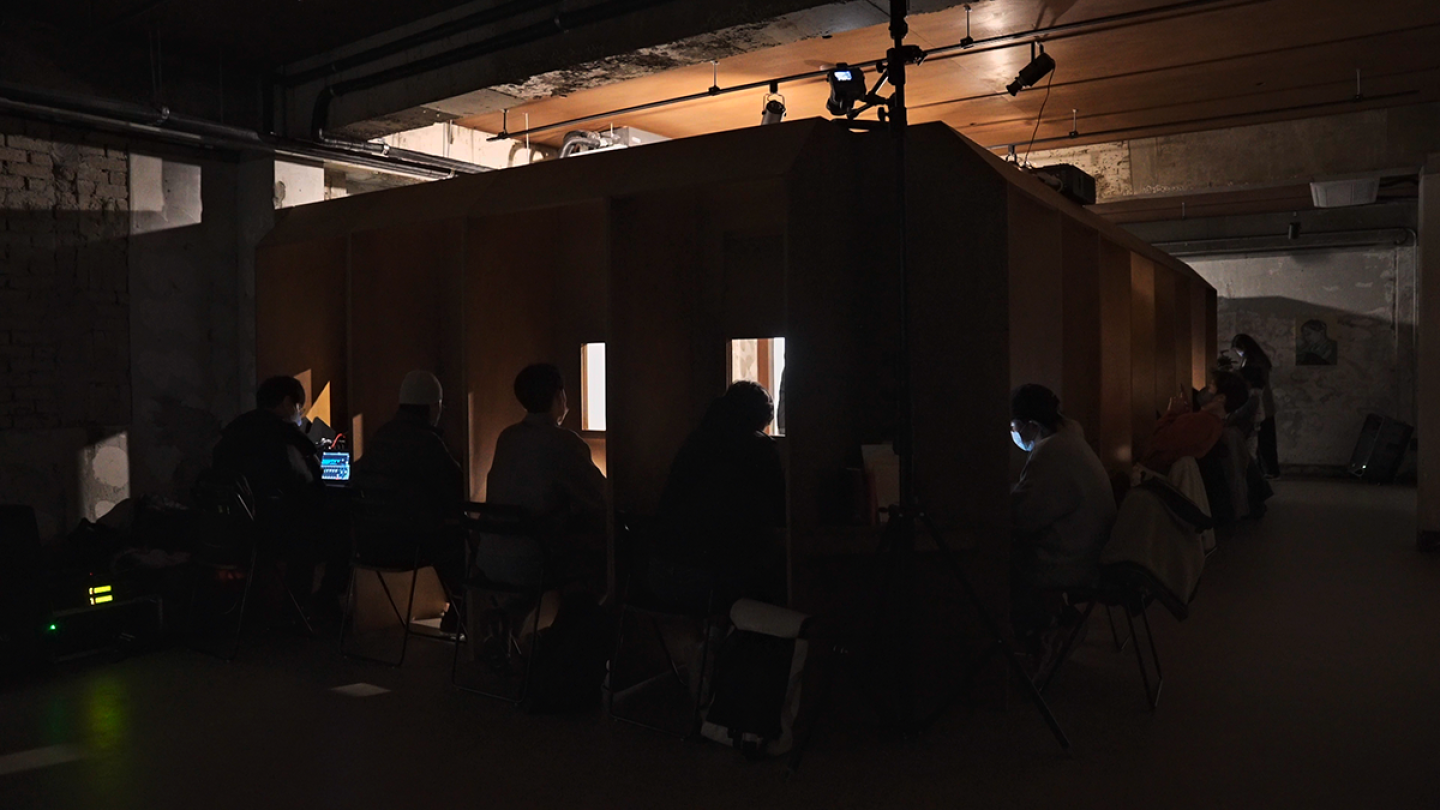
토론극장:우리_들 10막 <Modern Loneliness>의 관객참여연극 中
박혜수가 수많은 설문조사와 자료 조사를 통해서 구축하는 현실적 데이터들은 위태로운 조건 속에서 살아가고 있는 보편적인 인간의 모습을 건져올리기 위한 기반이다. 그러나 여기에서 박혜수가 포착하는 ‘보편’이라는 것이 사회적으로 규범화된 ‘보편’과는 차이가 있다는 것이 중요하다. 그의 ‘보편’은 표준화된 공통의 잣대가 아니라, 인간의 본질이 공유하는 공통 토대로서의 보편을 의미하는 것이다. 바로 이러한 점이 박혜수의 작업이 보다 많은 관객을 향해 이야기를 건네고 그들을 새로운 작업의 서사 안으로 지속적으로 초대해 왔던 동력일 것이다. 우리는 모두 박혜수의 작업을 통해서 타자의 이야기가 아닌, 나를 포함한 우리의 이야기를 보고 들을 수 있기 때문이다. 그가 만들어내는 인간 서사는 개인성을 해치지 않으면서도 공동의 영역일 수 있는 보편성에 기반하며, 이 사회의 집단성이 만들어내는 수많은 문제와 상처들에 대한 진단과 치유의 과정을 담고 있기도 하다. ⟪모노포비아⟫ 전시에서 실제 히키 코모리의 사연으로 이루어지는 낭독극, 관객 참여형 연극, 히키코모리 관련 활동가들과의 협업이 그의 작업과 연동될 수 있는 이유가 바로 이 때문이다. 박혜수는 보편적 인간 서사의 극이 펼쳐지는 무대를 열고 수많은 이들을 그 안으로 초대한다. 이러한 과정을 통해 그는 사회적 활동가와는 또 다른 영역에서 예술을 통한 사회 개입과 치유의 길을 만들어가고 있는 것이다.